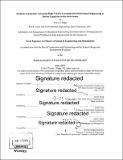| dc.contributor.advisor | Steven Spear and Daniel Frey. | en_US |
| dc.contributor.author | Rapp, Travis J.(Travis Joseph) | en_US |
| dc.contributor.other | Massachusetts Institute of Technology. Department of Mechanical Engineering. | en_US |
| dc.contributor.other | Massachusetts Institute of Technology. Engineering and Management Program. | en_US |
| dc.contributor.other | System Design and Management Program. | en_US |
| dc.date.accessioned | 2019-10-16T21:32:04Z | |
| dc.date.available | 2019-10-16T21:32:04Z | |
| dc.date.copyright | 2019 | en_US |
| dc.date.issued | 2019 | en_US |
| dc.date.issued | 2019 | en_US |
| dc.identifier.uri | https://hdl.handle.net/1721.1/122610 | |
| dc.description | Thesis: Nav. E., Massachusetts Institute of Technology, Department of Mechanical Engineering, 2019 | en_US |
| dc.description | Thesis: S.M. in Engineering and Management, Massachusetts Institute of Technology, System Design and Management Program, 2019 | en_US |
| dc.description | Cataloged from PDF version of thesis. | en_US |
| dc.description | Includes bibliographical references (pages 161-165). | en_US |
| dc.description.abstract | As the nation's security needs call for a growing naval fleet, the public-private industrial base for construction and weapon system acquisition will be stressed to perform at a high level of operational excellence. While reaching the required fleet size is a major challenge, ships are the delivery vehicles for complex weapons systems whose design and production is equally critical to deliver capability that the Fleet needs. Underperformance in defense acquisitions is found to be caused by complexity, uncertainty, and risk manifested through poor requirements that are unadaptable to the changing reality of the global security landscape. This thesis hypothesizes that use of model-based engineering (MBE) will enable the needed efficiency and responsiveness. | en_US |
| dc.description.abstract | MBE consists of digital tools motivated by the principles of traceability and high-velocity design iteration that collectively connect requirements to technical specifications in a model-centric format in contrast to the document-based form prevalent today. Given the problem of disengagement between the request for proposal and the finished product, prior case examples of using MBE elsewhere in the defense and industrial establishment show a bridge for the divide between capability requirements and technical realization. An original process-based shipbuilding production model further demonstrates how understanding effects of component changes affects overall system production. Changes in a ship's required operational capabilities, translated to technical design parameters, are mapped to production steps. The simulated performance is compared across three successive stages of construction when the change is ordered. | en_US |
| dc.description.abstract | Results of model simulations demonstrate that similar MBE applications contribute to increased early requirement fidelity, decreases in rework through missed changes, and more rapid design iteration when the models used are properly verified and validated. Verification and validation (V&V) must be performed in a very specific environment to engender confidence in model usage through a systemic framework. One method of V&V, System Theoretic Process Analysis for Security, is illustrated using an original concept illustration of a Fictional Submarine Strategic Missile. The domain of MBE is expanded to include definition of cybersecurity requirements for a new weapon system to illustrate an iteration of model-based system design. The modeling of these requirements contributes to validated resilience upon delivery, decreasing the likelihood that cyber-physical systems will be forced to rely on time-consuming updates that delay the capability delivery. | en_US |
| dc.description.statementofresponsibility | by Travis J. Rapp. | en_US |
| dc.format.extent | 165 pages | en_US |
| dc.language.iso | eng | en_US |
| dc.publisher | Massachusetts Institute of Technology | en_US |
| dc.rights | MIT theses are protected by copyright. They may be viewed, downloaded, or printed from this source but further reproduction or distribution in any format is prohibited without written permission. | en_US |
| dc.rights.uri | http://dspace.mit.edu/handle/1721.1/7582 | en_US |
| dc.subject | Mechanical Engineering. | en_US |
| dc.subject | Engineering and Management Program. | en_US |
| dc.subject | System Design and Management Program. | en_US |
| dc.title | Resilient acquisition : unlocking high-velocity learning with model-based engineering to deliver capability to the fleet faster | en_US |
| dc.type | Thesis | en_US |
| dc.description.degree | Nav. E. | en_US |
| dc.description.degree | S.M. in Engineering and Management | en_US |
| dc.contributor.department | Massachusetts Institute of Technology. Department of Mechanical Engineering | en_US |
| dc.contributor.department | Massachusetts Institute of Technology. Engineering and Management Program | en_US |
| dc.identifier.oclc | 1117714310 | en_US |
| dc.description.collection | Nav.E. Massachusetts Institute of Technology, Department of Mechanical Engineering | en_US |
| dc.description.collection | S.M.inEngineeringandManagement Massachusetts Institute of Technology, System Design and Management Program | en_US |
| dspace.imported | 2019-10-16T21:32:02Z | en_US |
| mit.thesis.degree | Master | en_US |
| mit.thesis.department | MechE | en_US |
| mit.thesis.department | SysDes | en_US |
